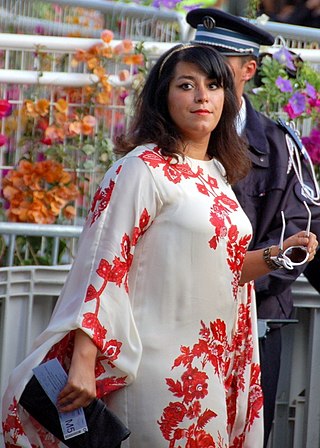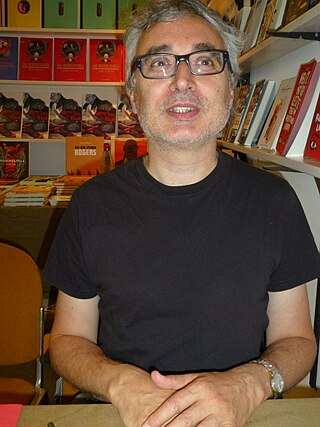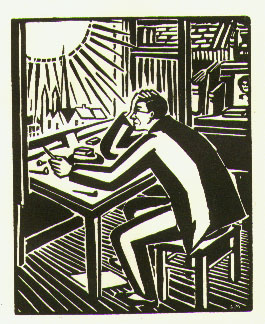Related Research Articles

Charles Pierre Baudelaire was a French poet who also worked as an essayist, art critic and translator. His poems are described as exhibiting mastery of rhyme and rhythm, containing an exoticism inherited from Romantics, and are based on observations of real life.

Epilepsy is a group of non-communicable neurological disorders characterized by recurrent epileptic seizures. An epileptic seizure is the clinical manifestation of an abnormal, excessive, and synchronized electrical discharge in the brain cells called neurons. The occurrence of two or more unprovoked seizures defines epilepsy. The occurrence of just one seizure may warrant the definition in a more clinical usage where recurrence may be able to be prejudged. Epileptic seizures can vary from brief and nearly undetectable periods to long periods of vigorous shaking due to abnormal electrical activity in the brain. These episodes can result in physical injuries, either directly such as broken bones or through causing accidents. In epilepsy, seizures tend to recur and may have no immediate underlying cause. Isolated seizures that are provoked by a specific cause such as poisoning are not deemed to represent epilepsy. People with epilepsy may be treated differently in various areas of the world and experience varying degrees of social stigma due to the alarming nature of their symptoms.

An epileptic seizure, informally known as a seizure, is a period of symptoms due to abnormally excessive or synchronous neuronal activity in the brain. Outward effects vary from uncontrolled shaking movements involving much of the body with loss of consciousness, to shaking movements involving only part of the body with variable levels of consciousness, to a subtle momentary loss of awareness. These episodes usually last less than two minutes and it takes some time to return to normal. Loss of bladder control may occur.

Les Fleurs du mal is a volume of French poetry by Charles Baudelaire.
Absence seizures are one of several kinds of generalized seizures. In the past, absence epilepsy was referred to as "pyknolepsy," a term derived from the Greek word "pyknos," signifying "extremely frequent" or "grouped". These seizures are sometimes referred to as petit mal seizures ; however, usage of this terminology is no longer recommended. Absence seizures are characterized by a brief loss and return of consciousness, generally not followed by a period of lethargy. Absence seizures are most common in children. They affect both sides of the brain.

Marjane Satrapi is a French-Iranian graphic novelist, cartoonist, illustrator, film director, and children's book author. Her best-known works include the graphic novel Persepolis and its film adaptation, the graphic novel Chicken with Plums, Woman, Life, Freedom and the Marie Curie biopic Radioactive.
The Prize for Best Album, also known as the Fauve d'Or, is awarded to comics authors at the Angoulême International Comics Festival. As is the customary practice in Wikipedia for listing awards such as Oscar results, the winner of the award for that year is listed first, the others listed below are the nominees.

Pierre-François "David" Beauchard, also known by the pen name David B., is a French comic book artist and writer, and one of the founders of L'Association.
An autobiographical comic is an autobiography in the form of comic books or comic strips. The form first became popular in the underground comix movement and has since become more widespread. It is currently most popular in Canadian, American and French comics; all artists listed below are from the U.S. unless otherwise specified.
Henri Jean Pascal Gastaut was a French neurologist and epileptologist.
L'Association is a French publishing house located in Paris which publishes comic books. It was founded in May 1990 by Jean-Christophe Menu, Lewis Trondheim, David B., Mattt Konture, Patrice Killoffer, Stanislas, and Mokeït.
Psychogenic non-epileptic seizures (PNES), which have been more recently classified as functional seizures, are events resembling an epileptic seizure, but without the characteristic electrical discharges associated with epilepsy. PNES fall under the category of disorders known as functional neurological disorders (FND), also known as conversion disorders. These are typically treated by psychologists or psychiatrists. PNES has previously been called pseudoseizures, psychogenic seizures, and hysterical seizures, but these terms have fallen out of favor.

Ilia Mikhailovich Zdanevich, known as Iliazd, was a Russian and French writer, artist and publisher, and an active participant in such avant-garde movements as Futurism and Dada.

My Friend Dahmer is a 2012 graphic novel and memoir by artist John "Derf" Backderf about his teenage friendship with Jeffrey Dahmer, who later became a serial killer. The book evolved from a 24-page, self-published version by Backderf in 2002.

Cirque du Freak, known as The Saga of Darren Shan in Japan, is a Japanese manga series illustrated by Takahiro Arai and based on the book series The Saga of Darren Shan by author Darren Shan. The series was published in Shogakukan's Weekly Shōnen Sunday from August 2006 to February 2009, with its chapters compiled in twelve tankōbon volumes.

The exorcism of a boy possessed by a demon, or a boy with a mute spirit, is one of the miracles attributed to Jesus reported in the synoptic Gospels, involving the healing of a demonically possessed boy through exorcism. It is in all Synoptic Gospels: Mark 9:17-29, Matthew 17:14-21, Luke 9:40-44. In the Gospel narratives, this healing takes place following the Transfiguration.

Bastien Lecouffe Deharme is a French visual artist, illustrator, digital painter and novelist, whose work is mainly in the science-fiction, cyberpunk and dark fantasy genre. He currently lives in Portsmouth, Ohio, US.
David Dusa is a Hungarian and Swedish film director.

The Sun is a wordless novel by Flemish artist Frans Masereel (1889–1972), published in 1919. In sixty-three uncaptioned woodcut prints, the book is a contemporary retelling of the Greek myth of Icarus.
Charlotte Dravet is a French paediatric psychiatrist and epileptologist.
References
Citations
- ↑ "Epileptic by David B.: Reviews". Metacritic. Archived from the original on 2008-01-25. Retrieved 2008-02-15.
- ↑ "Fiction Review: Epileptic". Publishers Weekly . Retrieved 3 February 2012.
Sources
- L'Ascension du haut mal at Bedetheque (in French)